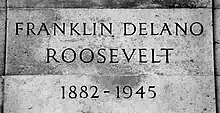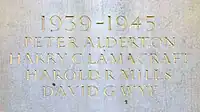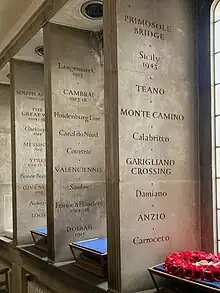William Sharpington
William Sharpington[lower-alpha 1] (1900–1973) was a British lettering artist who worked in sign painting and design of monuments.[8][9][10][11][12][lower-alpha 2] According to John Nash and Gerald Fleuss, his workshop "produced, from the 40s to the 60s, some of the most distinguished public lettering in England".[14]
William H. Sharpington | |
|---|---|
 William Sharpington working on lettering at the Adelphi in 1951[1] | |
| Born | 1900 |
| Died | 1973 |
| Occupation | Lettering artist |
| Employer | City and Guilds of London Art School |
| Spouse(s) | Claire Sharpington, [4] m. 1933[5] |

Career
.JPG.webp)
The son of a baker, Sharpington studied at the City and Guilds of London Art School[2] and started his career working as an assistant in the workshop of Percy Delf Smith from about 1920 to 1935, before setting up his own practice which continued through the post-war period.[6][16] Delf Smith and his teacher Edward Johnston had established a style of fine lettering rooted in Roman square capitals which had quickly become a standard for prestigious lettering like monuments and memorials.[17] Sharpington also worked in this style, with use of italics, calligraphy and swashes.[16][lower-alpha 3] Nick Garrett, a modern signwriter, comments that "I had worked alongside his lettering in the House of Lords some years earlier and they left such a lasting impression ... Sharpington's work is of course notably classical, yet each letter was made from his own passion for calligraphic rendering. The structures are strongly reminiscent of the original Trajan (Roman) and Jensen (Venetian) inspirational characters."[9][20]

.jpg.webp)
Sharpington designed lettering art such as memorials and painted signs himself, but generally drew out art for others to cut into stone.[15] He taught and had his workshop at the City and Guilds of London Art School.[16] His assistants and subcontractors included Kenneth Breese,[16][21] Ron Burnett,[22] Bob DuVivier[23] and Donald Jackson[13][lower-alpha 4] and his pupils included Michael Renton,[24][25] Vera Ibbett[26] and Stephen Lubell, whose article on him made with Burnett's assistance is one of the main sources on his life.[27] Sharpington's work included the lettering on the Roosevelt Memorial in Grosvenor Square[7] and the memorial to John Collis Browne.[15][28]
_(cropped).jpg.webp)

Much of Sharpington's artwork was painted or made of wood and ephemeral, such as his signs for London County Council for schools and vaccination clinics[5][16] (even as mundane as a "No Parking" sign to go at the entrance to a North London park).[14][lower-alpha 5] As a result, much of it no longer exists: by 1989 Dr. John Nash[31][32][33] commented that "much of the beautiful work done by Sharpington's workshop during the Fifties is now gone".[8][3][lower-alpha 6] (Giving a memorial lecture to Delf Smith in 1946, M. C. Oliver commented that Sharpington "specializes in painted lettering of fine quality".[6]) However, photographs exist of some of his lost work[27][14][36] and other examples survive which were made of stone, kept indoors or in protected locations such as government buildings.[37][10][lower-alpha 7] Lettering examples by him are held by the Crafts Study Centre.[39]
Sharpington was a Freemason in a lodge with Oliver, and later with Jackson.[13] He died in 1973 and was commemorated with a plaque at St Bride's Church, a former client.[22][28]
Extant work

- London Scottish Regiment Chapel, St Columba's Church, London, memorial lettering[22]
- Memorial to John Collis Browne, Ramsgate, Kent (1973)[22][40]
- British Museum, staff war memorial (1939–1945 section only; the First World War section is by Eric Gill)[41][42]
- With other artists: war memorial, interior of St Anne's Church, Kew[43][lower-alpha 8]
- Memorial to Sir Theodore Chambers, Parkway, Welwyn Garden City, monument designed by Louis de Soissons (c. 1961)[44]
- Roosevelt Memorial, Grosvenor Square, lettering[34][7]
- Plaque marking the York Water Gate, Victoria Embankment Gardens[45]
- A History of English Life (1936), book, lettering on maps and charts[46]

- Memorial to Edith Somerville and Violet Florence Martin, Saint Barrahane's Church, Castletownshend, Ireland[47][48]
Notes
- Sharpington was sometimes called W. H. Sharpington.[6][7] His middle name is not stated in sources.
- Sharpington preferred the term "lettering artist" to describe his work, rather than "sign writing", feeling that the term did not do lettering work due credit.[13][3]
- His Collis Browne memorial uses a capital-form q in lower-case italic, a style used in renaissance calligraphy[18] and by some twentieth-century Roman lettering artists, it is used for example in Jamie Smith's English Engravers typeface.[19]
- Interviewed years later for an oral history project, Jackson commented that Sharpington tended to charge prices that were too low: "he just didn't have a feel for what it ought to be ... he realised that the best thing to do was to give me the job and I was to give him the cut so I would get straight to the client".[13]
- The use of sign writing was much more common in this period because of the inflexibility of printing large fonts using letterpress, before the arrival of computer fonts, plotters and wide-format printers.[29][30]
- A signboard Lubell reproduces that Sharpington created for a toll road at Alleyn's College survives but the lettering has been replaced; it is not the same as in Burnett's photograph.[34][35]
- The Diocese of Southwark archives list correspondence with him on various projects.[38]
- Surrey County Council's website on the memorial credits Sharpington among other artists, but does not state which work he did. The memorial was dedicated in 1921, before Sharpington had set up his own practice, but rededicated in 1951 after the Second World War.[43]
References
- Hampton, J. A. "Mr W. Sharpington begins work on a memorial inscription at the Adelphi in London". Getty Images. Retrieved 28 August 2023.
- Nash 1989, p. 13.
- Nash 1989, p. 15.
- "Mrs Claire Sharpington Painting A Plaque Designed By Her Husband For A Building Which Stands On The Site Of The Former Adelphi Terrace". Shutterstock. Retrieved 28 August 2023.
- Nash 1989, p. 14.
- Oliver, M. C. (1950). "Percy Smith Memorial Lecture: The Revival of Writing Lettering and Illuminating". Journal of the Royal Society of Arts. 98 (4830): 916. ISSN 0035-9114.
- Sheppard, F. H. W., ed. (1980). "Grosvenor Square: Introduction". Survey of London: Volume 40, the Grosvenor Estate in Mayfair, Part 2 (The Buildings). London. pp. 112–117. Retrieved 27 August 2023.
- Lubell 2010, p. 22.
- Garrett, Nick (6 August 2022). "Wartski case history NGS Design & Gild – NGS Sign lettering & writing". Nick Garrett Signwriter. Retrieved 27 August 2023.
- "Pen to Printer: Edward Johnston Foundation Seminar". BLAG (Better Letters Magazine). 7 April 2014. Retrieved 27 August 2023.
- "Special Report: The Royal Hospital School commemorated at Greenwich". The Royal Hospital School Magazine. No. 25. October 1963. pp. 13–14. Retrieved 27 August 2023.
- Gardner, William (1982). Alphabet at Work. New York: St. Martin's Press. p. 18.
- Jackson, Donald; Hughes, Hawksmoor (2005). Donald Jackson interviewed by Hawksmoor Hughes – British Library. British Library. Event occurs at 9:18, 10:56, 12:26, 13:44.
- Nash, John; Fleuss, Gerald (1992). Practical Calligraphy. Hamlyn. p. 131.
- Lubell 2010, p. 25.
- Nash 2002, p. 22.
- Nash 2002.
- Shaw, Paul. "Flawed Typefaces". Paul Shaw Letter Design. Retrieved 28 August 2023.
- Smith, Jamie. "English Engravers Roman". MyFonts. Smith Hands. Retrieved 26 August 2023.
- Garrett, Nick (25 July 2020). "London's Hand Painted Gold House Numbers". Nick Garrett Signwriter. Retrieved 28 August 2023.
- Nash 2001b, pp. 15–16.
- Lubell 2010, p. 27.
- Nash 1999, p. 24.
- Nash 2001a, p. 9.
- Nash, John. "Michael Renton: His Hands Magic (abridged digital preview copy)". Issuu. Charlie Behrens/The Lettering & Commemorative Arts Trust. Retrieved 31 August 2023.
- "Flowers in Heraldry". Darvill's Rare Prints. Retrieved 27 August 2023.
- Lubell 2010.
- Morgan, Dewi (1973). Phoenix of Fleet Street: 2000 years of St. Bride's. p. 260.
- Simonson, Mark. "Not a font". Mark Simonson Studio (blog). Retrieved 14 December 2016.
- Astbury, Becky. Have Brush Will Travel: the Past, Present and Future of Signwriting (Thesis). p. 36. Retrieved 26 August 2023.
[From interview with the sign painter James-Roy Thomas]: The decline of the trade pretty much happened when the vinyl plotter came out ... for business to get something in their hands by the end of the day as opposed to the end of the week or more, it seems like a no-brainer.
- Clinton, Jane (5 May 2017). "Expert who hones his skills to the letter". Camden New Journal. Retrieved 26 August 2023.
- "John Nash". The Lettering Arts Trust. 12 April 2018. Retrieved 26 August 2023.
- "John Nash". The Art Workers’ Guild. Retrieved 26 August 2023.
- Lubell 2010, p. 24.
- Foster, Noel. "Geograph:: Toll sign, College Road, Dulwich © Noel Foster cc-by-sa/2.0". Geograph Britain and Ireland. Retrieved 28 August 2023.
- Holme, Rathbone; Frost, Kathleen M. (eds.). Modern Lettering and Calligraphy. The Studio Publications. pp. 100–101.
- "Enjoy Yourself". Crafts Study Centre. Retrieved 27 August 2023.
- "London Metropolitan Archives: Diocese of Southwark" (PDF). London Metropolitan Archives. Retrieved 18 September 2023.
- "Roman and Italic capitals". Crafts Study Centre. Retrieved 27 August 2023.
- Long, Donald G. Occasional Ramsgate Writings.
- Day, Michael. "A Museum Clerk at the Battle of the Somme". British Library. Retrieved 27 August 2023.
- "Frontispiece". British Museum Quarterly. June 1953. Retrieved 28 August 2023.
- "Kew, St Anne's, Men Of Kew Memorial". Surrey in the Great War: A County Remembers. Surrey County Council. Retrieved 27 August 2023.
- "Memorial to Sir Theodore". Monumental Journal and Commemorative Art. 28: 318. 1961. Retrieved 18 September 2023.
The memorial was designed by Mr. Louis de Soissons...with lettering by Mr. W. H. Sharpington
- Lubell 2010, p. 26.
- Williams-Ellis, Amabel; Fisher, F. J.; Hickson, Wilma (1936). A History of English Life: Political and Social. London: Methuen. p. iv.
- Hutchison, Sam. The Light of Other Days: a selection of monuments, mausoleums and memorials in Church of Ireland churches and graveyards and those whom they commemorate. pp. 87–89.
They are...commemorated in a delightful tablet on the north wall of the same church, designed by W. H. Sharpington and subscribed for by friends and admirers in America.
- Ellis, Jacky. "Edith Somerville memorial plaque in the Church of Saint Barrahane at Castletownshend Stock Photo – Alamy". Alamy. Retrieved 28 August 2023.
Cited literature
- Gibbs, Jon. "Henry Hooper: Lettering Craftsman". The Edward Johnston Foundation Journal: 3–8.
- Lubell, Stephen (2010). "William Sharpington: a man of letters". Ultrabold: The Journal of St Bride Library (8): 22–27.
- Nash, John R. (1989). "English Brush Lettering: The Workshop of William Sharpington". The Scribe: 13–15.
- Nash, John R. (1999). "Bob DuVivier". The Edward Johnston Foundation Journal: 24.
- Nash, John R. (2001a). "Michael Renton 1934–2001". The Edward Johnston Foundation Journal: 9–10.
- Nash, John R. (2001b). "Kenneth Breese, Lettering Craftsman". The Edward Johnston Foundation Journal: 15–22.
- Nash, John R. (2002). "In Defence of the Roman Letter" (PDF). The Edward Johnston Foundation Journal. Retrieved 13 October 2016.
- Shaw, John (1988). "Percy John Delf Smith R.D.I.". Calligraphy Review: 17–26.
- Shaw, John (2007). "Percy John Delf Smith RDI 1882–1948: Calligrapher, Lettering Artist and Craftsman". The Edward Johnston Foundation Journal: 2–10.
External links
- Lettering model at the Crafts Study Centre
- Sharpington working in 1951